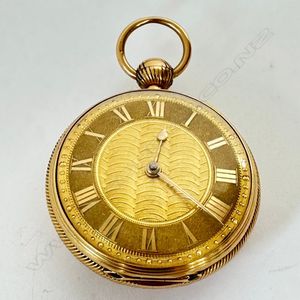Regency Pocket Watch by Robert Roskell, Liverpool (1820)
18ct gold Regency period, open face, pocket watch by Robert Roskell, Liverpool, number 28869. 46 mm case with engine-turned back cover, diagonally milled bad, hallmarked Chester 1820. Matched number to movement. Gold dial with scale pattern centre, matt chapter ring with raised gold Roman numerals, minute indices, gold hands. Rack lever escapement, fusee/chain movement, signed 'Robt. Roskell, Liverpool. 28869' 104gm
You must be a subscriber, and be logged in to view price and dealer details.
Subscribe Now to view actual auction price for this item
When you subscribe, you have the option of setting the currency in which to display prices to $Au, $US, $NZ or Stg.
This item has been sold, and the description, image and price are for reference purposes only.
- Chapter Ring - A separate metal plate on the face of a clock, on which the numerals for the hours and sometimes parts of the hours, are displayed, usually wheel shaped and sitting on top of the dial plate. The chapter ring is often a feature of the clock and can be silvered or enamelled to stand as a contrast to its background. The hours are usually shown in Roman numerals, although in the late 19th and earlt 20th century, Arabic numerals became fashionable.
- Movement - The technical name for the workings of a clock or watch, and does not include the dial or case.
- Regency Period - The Regency period in English furniture design refers to the period when King George III, was declared unfit to rule in 1811, and his son ruled as proxy as Prince Regent, until 1820, and then, after the death of his father as George IV until his death in 1830. The Regency period was preceded by the Georgian period (George I, George II, and George III: 1714 - 1811), and was followed by the William IV period, which only lasted until 1837 when William IV died as was succeeded by Queen Victoria.
- Hunt & Roskell - Hunt & Roskell, were a firm of manufacturing and retail jewellers and silversmiths, founded in 1843 by Robert Roskell a famous pocket watch maker from Liverpool, and John Samuel Hunt who had previously been in partnership with silversmith Paul Storr, trading Storr & Co. (1819-22), Storr & Mortimer (1822-38), Mortimer & Hunt (1838-43) and then Hunt & Roskell (1843-97).
Hunt & Roskell had retail premises at 156 New Bond Street and a manufacturing workshops at 26 Harrison Street, near Clerkenwell.
They were among the finest of the Victorian silversmith, manufacturing in the high Victorian style, and their craftsmanship was recognised by their appointment as silversmiths and jewellers to Queen Victoria.
John Samuel Hunt continued as a partner until his death in 1865, when he was succeeded by his son, John Hunt (d.1879). Robert Roskell remained in the firm until his death in 1888. In 1889 the firm was taken over by J.W. Benson and continued in business as Hunt & Roskell Ltd until c.1965. - Lever Escapement - A lever escapement is a type of escapement mechanism used in mechanical clocks and watches to regulate the timekeeping of the movement. It was invented by British clockmaker Thomas Mudge in the 18th century and is now widely used in modern mechanical timepieces.
The lever escapement consists of three main parts: the escape wheel, the pallet fork, and the lever. The escape wheel is a wheel with teeth that is driven by the clock or watch's main spring or weight. The pallet fork is a two-pronged component that is positioned so that it can engage with the teeth of the escape wheel, and the lever is a small, L-shaped component that is attached to the pallet fork.
When the escape wheel turns, one of its teeth pushes against one of the pallet fork's prongs, causing the fork to pivot. As the pallet fork pivots, it releases the tooth and engages with the next tooth on the opposite side of the escape wheel. At the same time, the lever, which is connected to the pallet fork, rocks back and forth, allowing the escape wheel to turn at a regulated rate.
The lever escapement is prized for its accuracy and reliability and is commonly used in high-end mechanical watches. It allows for precise timekeeping by ensuring that the movement of the watch or clock is regulated and consistent, and its compact size makes it an ideal choice for use in small, portable timepieces.
This item has been included into following indexes:
